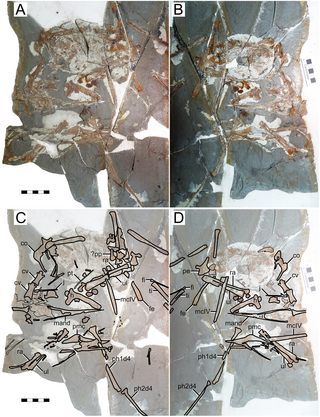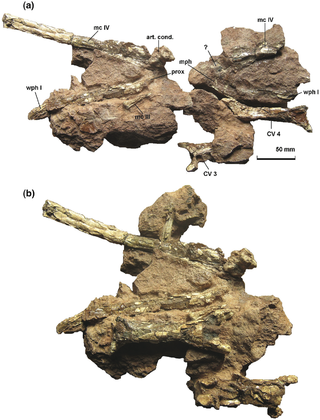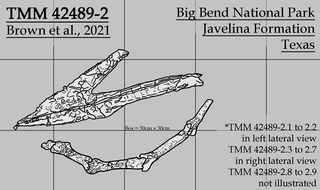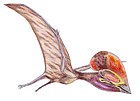
Azhdarchidae is a family of pterosaurs known primarily from the Late Cretaceous Period, though an isolated vertebra apparently from an azhdarchid is known from the Early Cretaceous as well. Azhdarchids are mainly known for including some of the largest flying animals discovered, but smaller cat-size members have also been found. Originally considered a sub-family of Pteranodontidae, Nesov (1984) named the Azhdarchinae to include the pterosaurs Azhdarcho, Quetzalcoatlus, and Titanopteryx. They were among the last known surviving members of the pterosaurs, and were a rather successful group with a worldwide distribution. Previously it was thought that by the end of the Cretaceous, most pterosaur families except for the Azhdarchidae disappeared from the fossil record, but recent studies indicate a wealth of pterosaurian fauna, including pteranodontids, nyctosaurids, tapejarids and several indeterminate forms.

Tupuxuara is a genus of thalassodromid pterosaur that lived during the Albian age of the Early Cretaceous, about 112 million years ago. Its remains were found in what is now the Romualdo Formation of the Santana Group in Brazil. Tupuxuara was named in 1988 by paleontologists Alexander Kellner and Diógenes de Almeida Campos. The name Tupuxuara means "familiar spirit" referring to a familiar spirit in the mythology of the Tupi people in Brazil. Two species have been named, T. longicristatus, the type species, and T. leonardii. An additional species has been named in 2013, T. deliradamus. However, the validity of this species has been put into question and it may not even belong to Tupuxuara.

Arambourgiania is a genus of azhdarchid pterosaur that lived during the Maastrichtian age of the Late Cretaceous, in what is now Jordan. Additional fossil remains from the United States and Morocco have also been found, but their assignment to Arambourgiania is only tentative. The original specimen was discovered in the 1940s by a railway worker near Russeifa, Jordan. After examination by paleontologist Camille Arambourg, a new species was named in 1959, Titanopteryx philadelphiae. The generic name means "titan wing", as the fossil was initially misidentified as a huge wing metacarpal, while the specific name refers to the ancient name of Amman, Philadelphia. The genus "Titanopteryx" would later be problematic, as it had already been taken by a fly. Because of this, paleontologist Lev Nessov in 1989 named a new genus, Arambourgiania, in honor of Arambourg. The new species was now known as Arambourgiania philadelphiae.

Hatzegopteryx is a genus of azhdarchid pterosaur found in the late Maastrichtian deposits of the Densuş Ciula Formation, an outcropping in Transylvania, Romania. It is known only from the type species, Hatzegopteryx thambema, named by paleontologists Eric Buffetaut, Dan Grigorescu, and Zoltan Csiki in 2002 based on parts of the skull and humerus. Additional specimens, including a neck vertebra, were later placed in the genus, representing a range of sizes. The largest of these remains indicate it was among the biggest pterosaurs, with an estimated wingspan of 10 to 12 m.
Bogolubovia is a genus of pterosaur from the Upper Cretaceous Rybushka Formation of Petrovsk, Saratov Oblast, Russia. It is named for Nikolai Nikolaevich Bogolubov, the paleontologist who discovered the remains in 1914.

Eopteranodon is a genus of tapejarid pterosaur from the Aptian-age Lower Cretaceous Yixian Formation of Beipiao City, Liaoning, China. The genus was named in 2005 by paleontologists Lü Junchang and Zhang Xingliao. The type species is Eopteranodon lii. A second species, E. yixianensis, was named in 2023, but its validity has been questioned.

Phosphatodraco is a genus of azhdarchid pterosaur that lived during the Late Cretaceous of what is now Morocco. In 2000, a pterosaur specimen consisting of five cervical (neck) vertebrae was discovered in the Ouled Abdoun Phosphatic Basin. The specimen was made the holotype of the new genus and species Phosphatodraco mauritanicus in 2003; the genus name means "dragon from the phosphates", and the specific name refers to the region of Mauretania. Phosphatodraco was the first Late Cretaceous pterosaur known from North Africa, and the second pterosaur genus described from Morocco. It is one of the only known azhdarchids preserving a relatively complete neck, and was one of the last known pterosaurs. Additional cervical vertebrae have since been assigned to the genus, and it has been suggested that fossils of the pterosaur Tethydraco represent wing elements of Phosphatodraco.

Aralazhdarcho is a genus of azhdarchid pterosaur that lived during the Santonian to the early Campanian ages of the Late Cretaceous period in what is now Kazakhstan. The type and only known species is Aralazhdarcho bostobensis, named and described by Russian paleontologist Alexander Averianov. Its remains were found in the Bostobe Formation of Kazakhstan. The generic name combines the Aral Sea and the related genus Azhdarcho, while the specific name refers to its origin from the Bostobe Formation.

Azhdarchoidea is a group of pterosaurs within the suborder Pterodactyloidea, more specifically within the group Ornithocheiroidea. Pterosaurs belonging to this group lived throughout the Early and Late Cretaceous periods, with one tentative member, Tendaguripterus, that lived in the Late Jurassic period. The largest azhdarchoids include members of the family Azhdarchidae, examples of these are Quetzalcoatlus, Hatzegopteryx, and Arambourgiania. Other notable pterosaur families belonging to the Azhdarchoidea are the Tapejaridae, the Thalassodromidae, and the Chaoyangopteridae. This group contains some of the most advanced members of the pterosaur order.
Elanodactylus is a genus of ctenochasmatid pterodactyloid pterosaur from the Early Cretaceous period of what is now the Yixian Formation of Liaoning, China.

Alanqa is a genus of pterodactyloid pterosaur from the Late Cretaceous period of what is now the Kem Kem Beds of southeastern Morocco. The name Alanqa comes from the Arabic word العنقاءal-‘Anqā’, for a mythical bird of Arabian culture.
Archaeoistiodactylus is an extinct genus of wukongopterid pterosaur from the Middle Jurassic of China.

Aerotitan is a genus of azhdarchid pterosaur that lived during the Maastrichtian age of the Late Cretaceous period in what is now Argentina. Its only remains, which consist of a partial snout, were found in the Allen Formation of the Neuquén Basin in northern Patagonia. This specimen was made the holotype of Aerotitan sudamericanus by paleontologist Fernando Novas and colleagues. The generic name combines the Greek word ἀήρ, meaning "air" and Titan, alluding to the pterosaur's large size. The specific name is a reference to its origin, South America.

Eurazhdarcho is a genus of azhdarchid pterosaur that lived during the Maastrichtian age of the Late Cretaceous period in what is now Romania, about 69 million years ago. Starting in 2009, pterosaur fossil remains were unearthed in a layer of the Sebeș Formation in Lancrăm, southwestern Transylvania by paleontologist Mátyás Vremir. In 2013, he, along with paleontologists Alexander Kellner, Darren Naish, and Gareth Dyke would name the new genus and type species Eurazhdarcho langendorfensis. Its generic name is a combination of Europe and the genus Azhdarcho, while its specific name is in reference to its origin from Langendorf. The holotype specimen of Eurazhdarcho consists of a partial skeleton that includes cervical (neck) vertebrae, metacarpal, and phalanx fragments. The related and much larger azhdarchid Hatzegopteryx has also been found in the same location, indicating a possibility that Eurazhdarcho may have a juvenile of this pterosaur. However, the describers deemed this unlikely as its fossils seem to represent an adult specimen.

Mistralazhdarcho is a genus of azhdarchid pterosaur that lived during the Campanian and Maastrichtian ages of the Late Cretaceous period in what is now France. A rich fossil site was discovered in 1992 by paleontologist Xavier Valentin at Velaux–La Bastide Neuve, in the south of France. Pterosaur fossil remains would be subsequently uncovered in the site. They were found in a layer of the Aix-en-Provence Basin at Velaux–La Bastide Neuve and consist of a partial skeleton that includes the skull. These remains would later be made the holotype specimen of the new genus and type species Mistralazhdarcho maggii, named and described in 2018 by Valentin, along with paleontologists Romain Vullo, Géraldine Garcia, Pascal Godefroit, and Aude Cincotta. The generic name combines the mistral, a typical northern wind from the area, and the related genus Azhdarcho. The specific name honors Jean-Pierre Maggi, the mayor of Velaux, who supported the La Bastide Neuve paleontological project.

Keresdrakon is an extinct genus of azhdarchoid pterosaur from the Goio-Erê Formation of Brazil, which dates back to the Early Cretaceous period, 125 to 100.5 million years ago. Keresdrakon contains a single species, Keresdrakon vilsoni.

Cryodrakon is a genus of azhdarchid pterosaur that lived during the late Campanian age of the Late Cretaceous period in what is now Canada, around 76.7 and 74.3 million years ago. Starting in 1972, fossil remains of large azhdarchid pterosaurs have been reported from Alberta. Paleontologists assigned them to the genus Quetzalcoatlus, given that it was the only known azhdarchid from North America back then and because they had limited information about its actual remains, so they simply could not deduce anything different. In 1992, a partial pterosaur skeleton was uncovered in the Dinosaur Park Formation of Alberta. It was partially described in 1995 by paleontologist Philip J. Currie and colleagues, with a subsequent and more complete description in 2005. But it was not until 2019 that it received a new genus and type species, Cryodrakon boreas, named and described by paleontologists David Hone, Michael Habib, and François Therrien. The partial skeleton was made the holotype specimen of this new pterosaur. Its generic name means "cold dragon" in Ancient Greek, in reference to its Canadian origin, while its specific name refers to the Greek god of the north winds, Boreas. All azhdarchid remains from the Dinosaur Park Formation were subsequently referred to Cryodrakon.
Albadraco is a genus of azhdarchid pterosaur that lived during the Maastrichtian age of the Late Cretaceous period in what is now Romania. The type species is Albadraco tharmisensis. Its remains, consisting of parts of the snout and a neck vertebra, were found in the Șard Formation, near the city of Alba Iulia in Transylvania. The species was named and described in 2019 by paleontologist Alexandru Solomon and colleagues.

Wellnhopterus is a genus of azhdarchid pterosaur that lived during the Maastrichtian age of the Late Cretaceous period in what us now Texas, United States. Its fossil remains were discovered in the Javelina Formation at Big Bend National Park, located in Brewster County, Texas. The fossils consist of a set of upper and lower jaws, several cervical (neck) vertebrae, and a fragmentary long bone. Originally referred to an indeterminate species of Quetzalcoatlus, these remains would receive various interpretations ranging from a tapejarid to an azhdarchid identity. It was not until December 2021 that they were given a new genus and type species, Wellnhopterus brevirostris, named and described by paleontologists Brian Andres and, posthumously, Wann Langston Jr.. Its generic name means "Wellnhofer's wing", named in honor of paleontologist Peter Wellnhofer, while its specific name means "short-beaked", attributing to the blunt structure of its jaws.

Thanatosdrakon is a genus of azhdarchid pterosaur that lived during the Coniacian and Santonian ages of the Late Cretaceous period in what is now Argentina, around 89.6 and 86.3 million years ago. Its remains were found in the Plottier Formation of the Neuquén Basin in the Mendoza Province. The genus only consists of the type species, Thanatosdrakon amaru, named and described by paleontologists Leonardo Ortiz David, Bernardo González Riga, and Alexander Kellner. Its generic name means "dragon of death" in Greek, while its specific name is a Quechuan word meaning "flying serpent" and refers to the Incan deity Amaru. Thanatosdrakon is known from two specimens, the holotype, consisting of a partial postcranial skeleton, and the paratype, consisting of a left humerus. The holotype includes material that is previously undescribed in giant azhdarchid pterosaurs.































